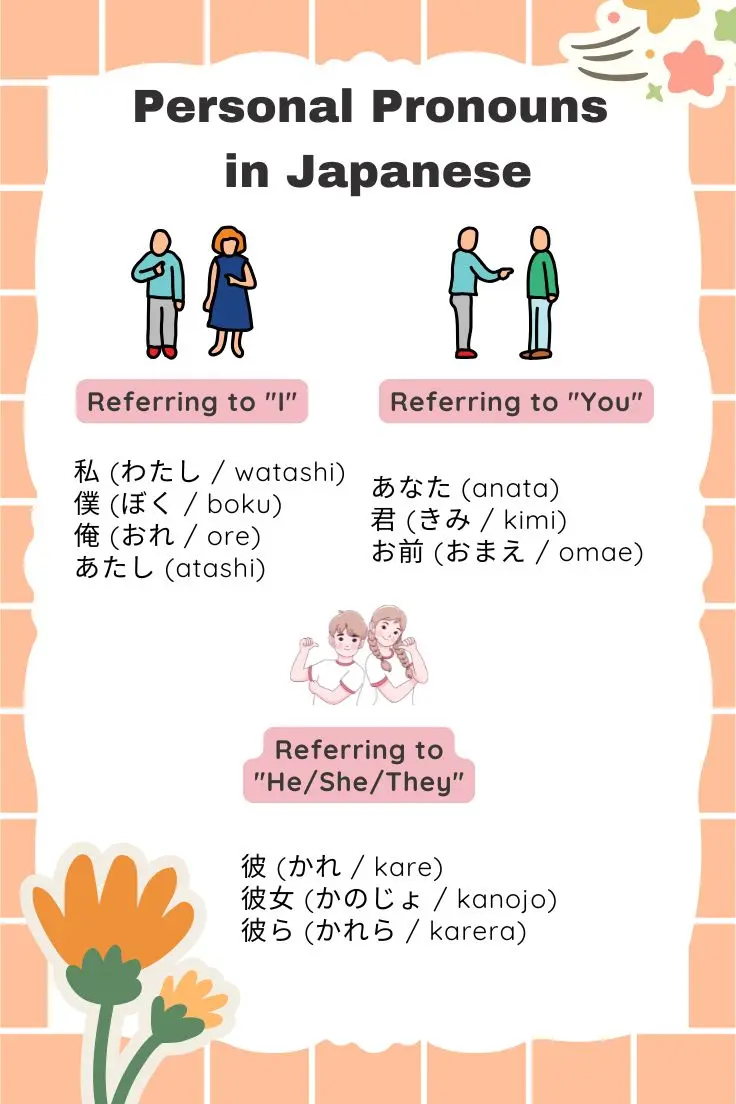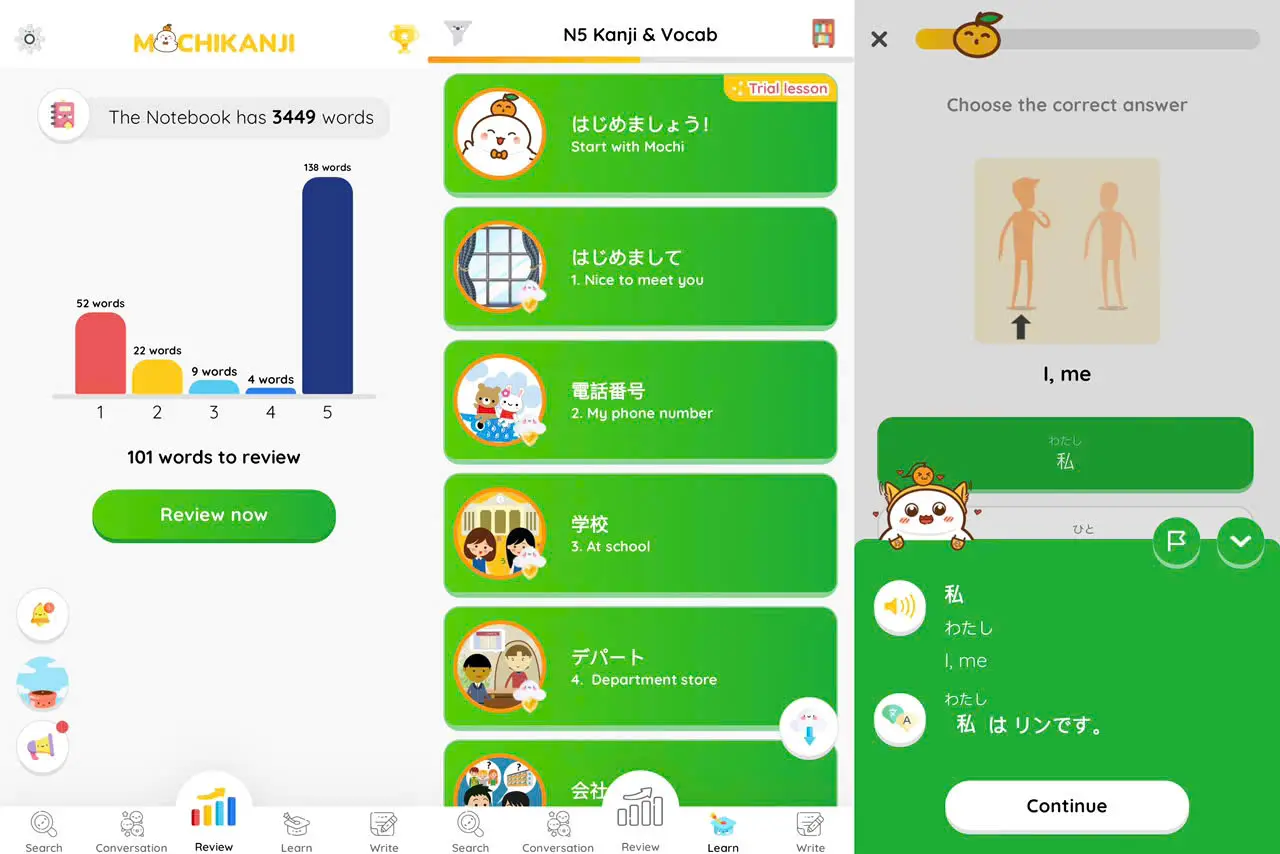Japanese pronouns are a fascinating aspect of the language, showcasing the nuances of Japanese culture and communication. Unlike English, where pronouns are indispensable for avoiding repetition, Japanese relies heavily on context, often omitting pronouns altogether. This reflects the indirect and context-sensitive nature of Japanese interaction, where respect and subtlety are paramount.
In this detailed guide, we’ll explore the types of Japanese pronouns, their specific uses, cultural significance, and tips for mastering them effectively.
1. What Are Japanese Pronouns?
Pronouns in Japanese serve the same fundamental purpose as in English: replacing nouns. However, their application is far more nuanced. The choice of pronoun can convey a speaker’s personality, social standing, gender identity, and level of formality, making them a vital part of effective communication.
Types of Japanese Pronouns:
- Personal pronouns: Refer to individuals (e.g., “I,” “you,” “he”).
- Demonstrative pronouns: Indicate objects, places, or directions (e.g., “this,” “that”).
- Interrogative pronouns: Pose questions (e.g., “who,” “what”).
2. Personal Pronouns in Japanese
Personal pronouns in Japanese are particularly diverse, with variations based on factors like gender, age, and the speaker’s relationship to the listener. Here’s a closer look:
2.1. First-Person Pronouns: Referring to “I”
Common Pronouns:
- 私 (わたし / watashi):
Neutral and polite, used in formal situations by men and women alike.
Example:
私は学生です。 (Watashi wa gakusei desu.)
I am a student. - 僕 (ぼく / boku):
Polite and masculine, often used by men in semi-formal settings.
Example:
僕は行きます。 (Boku wa ikimasu.)
I will go. - 俺 (おれ / ore):
Casual and masculine, implying confidence or familiarity.
Example:
俺がやるよ。 (Ore ga yaru yo)
I’ll do it. - あたし (atashi):
Informal and feminine, often used by women in casual settings.
Example:
あたしは忙しい。 (Atashi wa isogashii.)
I’m busy.
2.2. Second-Person Pronouns: Referring to “You”
Japanese second-person pronouns are used sparingly, as direct references can come across as impolite. Instead, names or titles are often preferred.
Common Pronouns:
- あなた (anata):
Polite but distant, often used in formal settings.
Example:
あなたはどう思いますか? (Anata wa dou omoimasu ka?)
What do you think? - 君 (きみ / kimi):
Casual and often used by men when addressing equals or juniors.
Example:
君は正しいよ。 (Kimi wa tadashii yo.)
You’re right. - お前 (おまえ / omae):
Informal and masculine, potentially rude depending on the tone and relationship.
Example:
お前、元気か? (Omae, genki ka?)
Hey, are you doing well?
2.3. Third-Person Pronouns: Referring to “He/She/They”
While third-person pronouns exist in Japanese, they are often replaced by names or descriptive phrases for clarity.
Common Pronouns:
- 彼 (かれ / kare):
He or boyfriend.
Example:
彼は医者です。 (Kare wa isha desu.)
He is a doctor. - 彼女 (かのじょ / kanojo):
She or girlfriend.
Example:
彼女は忙しいです。 (Kanojo wa isogashii desu.)
She is busy. - 彼ら (かれら / karera):
They (male or mixed group).
Example:
彼らは来ます。 (Karera wa kimasu.)
They will come.
3. Demonstrative Pronouns in Japanese
Demonstrative pronouns are categorized based on their distance relative to the speaker and listener, a system known as ko-so-a-do.
3.1. Objects: Ko-So-A-Do Words
- こ (ko): Near the speaker.
Example: これ (kore) = This. - そ (so): Near the listener.
Example: それ (sore) = That. - あ (a): Far from both.
Example: あれ (are) = That over there. - ど (do): Question form.
Example: どれ (dore) = Which.
Example sentence:
これは何ですか? (Kore wa nan desu ka?)
What is this?
3.2. Locations: Ko-So-A-Do for Places
- ここ (koko): Here.
- そこ (soko): There.
- あそこ (asoko): Over there.
- どこ (doko): Where.
Example sentence:
トイレはどこですか? (Toire wa doko desu ka?)
Where is the bathroom?
4. Interrogative Pronouns in Japanese
Interrogative pronouns are essential for asking questions in Japanese.
Examples:
- 誰 (だれ / dare): Who.
Example:
彼は誰ですか? (Kare wa dare desu ka?)
Who is he? - 何 (なに / nani): What.
Example:
何を飲みますか? (Nani o nomimasu ka?)
What will you drink? - どれ (dore): Which.
Example:
どれが好きですか? (Dore ga suki desu ka?)
Which one do you like?
5. Cultural Insights into Japanese Pronouns
Understanding Japanese pronouns requires more than memorization; it involves appreciating the cultural context.
- Avoid Overuse: Pronouns are often omitted when the subject is clear from context.
- Politeness Levels: Using inappropriate pronouns can come across as disrespectful.
- Gendered Speech: Some pronouns are strongly associated with masculinity or femininity.
6. Practice Japanese Pronouns with MochiKanji
MochiKanji’s spaced repetition flashcards and clever review system make it an effective tool for learning Japanese vocabulary, including personal pronouns. It makes it easier for students to remember important words and characters. Try MochiKanji now to learn more about personal pronouns and become more fluent in Japanese!
Conclusion
Japanese pronouns are intricate yet rewarding to learn, offering insights into the language’s cultural richness. By understanding their usage and practicing regularly, you’ll gain a deeper appreciation for Japanese communication. Start your journey today with tools like MochiKanji, and watch your language skills flourish!








